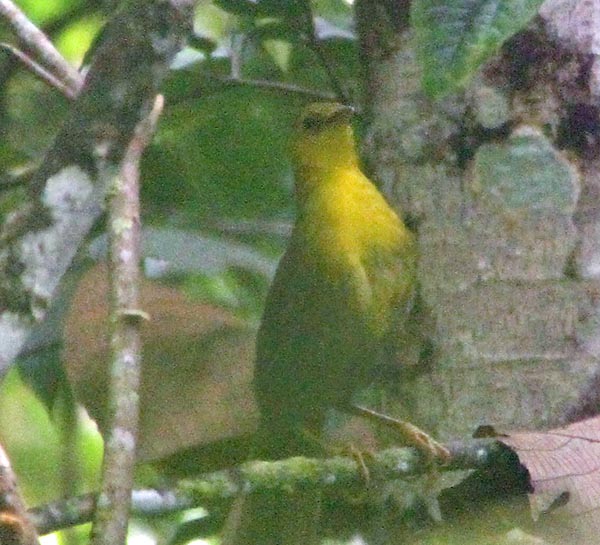
a web page by Don Roberson |
MALIA Malia grata |
|
 |
 The Malia
is a mysterious arboreal passerine in montane Sulawesi. Small noisy
groups — possibly just families or extended families —forage rapidly in
the vines and tangles of the canopy and mid-canopy (all photos ©
D. Roberson). It is not particularly rare, but its affinities are
entirely unknown. No molecular evidence has yet been published (as of
March 2012). White & Bruce (1986) summarize: "Malia's
systematic position is obscure. It is usually listed with the babblers
(Timaliidae) but ... for no specific reason. In the only specimen
examined, the outer margin of the inner webs of the inner primaries and
secondaries is dull fawn contrasting with the drab brown of the rest of
the feathers, a .... characteristic of the bulbuls. It its coloration Malia
is quite similar to many bulbuls." White & Bruce tentatively placed
it among Bulbuls (family Pycnonotidae). Sibley & Monroe (1990),
Dickinson (2003), and IOC checklists currently place it with Bulbuls.
However, Handbook of the Birds of the World (Collar & Robson 2007) and current Clements checklist put it with the Tree Babblers (Timaliidae) The Malia
is a mysterious arboreal passerine in montane Sulawesi. Small noisy
groups — possibly just families or extended families —forage rapidly in
the vines and tangles of the canopy and mid-canopy (all photos ©
D. Roberson). It is not particularly rare, but its affinities are
entirely unknown. No molecular evidence has yet been published (as of
March 2012). White & Bruce (1986) summarize: "Malia's
systematic position is obscure. It is usually listed with the babblers
(Timaliidae) but ... for no specific reason. In the only specimen
examined, the outer margin of the inner webs of the inner primaries and
secondaries is dull fawn contrasting with the drab brown of the rest of
the feathers, a .... characteristic of the bulbuls. It its coloration Malia
is quite similar to many bulbuls." White & Bruce tentatively placed
it among Bulbuls (family Pycnonotidae). Sibley & Monroe (1990),
Dickinson (2003), and IOC checklists currently place it with Bulbuls.
However, Handbook of the Birds of the World (Collar & Robson 2007) and current Clements checklist put it with the Tree Babblers (Timaliidae) |
| Delacour (1946) commented that Malia's coloration, thin bill and strong feet perhaps suggest a bulbul adapted to a partly terrestrial life. Mostly, though, as Heinrich, the discoverer described, they were found "in the tops of trees in mossy forest [where they] moved swiftly through the hanging moss like a squirrel" (White & Bruce 1986). That certainly is consistent with behavior I saw, but do note the large feet in most of the photos. Three subspecies are described (grata, stresemanni, recondita), differing primarily in the intensity of yellow underparts and comparative color of the tail, but song dialects are also described. Two subspecies are shown on this page: central Sulawesi stresemanni is the top photo; the rest are northern Sulawesi recondita. |
 |
The IOC checklist announces that genetic research on Malia is underway. Perhaps it will not be that much longer until we finally determine what it is. |
Photos: All Malia Malia grata were photographed in Sulawesi, Indonesia, in Oct 2011. The top photo, of race stresemanni, was in Lore Lindu NP on 1 Oct; the remaining photos, of race recondita, were at Gunung Ambang Nature Reserve on 5 Oct. Photos © Don Roberson; all rights reserved. Literature cited:
|
 Malia
are noisy birds, with much group chatter and churring, interspersed
with whistles and squeals. They apparently feed heavily on beetles and
grasshoppers, and they use their bills to big into rotten wood,
dislodge moss and loose bark, and glean from trunks and large limbs
(Collar & Robson 2007). Because their movements are rapid in the
mossy canopy, and sunlight is at best patchy in that environment,
photographs are rather few. I spent quite a lot of time over three
different days trying to obtain even these marginal shots.
Malia
are noisy birds, with much group chatter and churring, interspersed
with whistles and squeals. They apparently feed heavily on beetles and
grasshoppers, and they use their bills to big into rotten wood,
dislodge moss and loose bark, and glean from trunks and large limbs
(Collar & Robson 2007). Because their movements are rapid in the
mossy canopy, and sunlight is at best patchy in that environment,
photographs are rather few. I spent quite a lot of time over three
different days trying to obtain even these marginal shots.